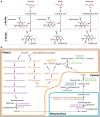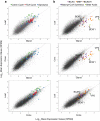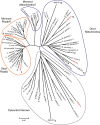Transcriptome analysis of bitter acid biosynthesis and precursor pathways in hop (Humulus lupulus)
- PMID: 23347725
- PMCID: PMC3564914
- DOI: 10.1186/1471-2229-13-12
Transcriptome analysis of bitter acid biosynthesis and precursor pathways in hop (Humulus lupulus)
Abstract
Background: Bitter acids (e.g. humulone) are prenylated polyketides synthesized in lupulin glands of the hop plant (Humulus lupulus) which are important contributors to the bitter flavour and stability of beer. Bitter acids are formed from acyl-CoA precursors derived from branched-chain amino acid (BCAA) degradation and C5 prenyl diphosphates from the methyl-D-erythritol 4-phosphate (MEP) pathway. We used RNA sequencing (RNA-seq) to obtain the transcriptomes of isolated lupulin glands, cones with glands removed and leaves from high α-acid hop cultivars, and analyzed these datasets for genes involved in bitter acid biosynthesis including the supply of major precursors. We also measured the levels of BCAAs, acyl-CoA intermediates, and bitter acids in glands, cones and leaves.
Results: Transcripts encoding all the enzymes of BCAA metabolism were significantly more abundant in lupulin glands, indicating that BCAA biosynthesis and subsequent degradation occurs in these specialized cells. Branched-chain acyl-CoAs and bitter acids were present at higher levels in glands compared with leaves and cones. RNA-seq analysis showed the gland-specific expression of the MEP pathway, enzymes of sucrose degradation and several transcription factors that may regulate bitter acid biosynthesis in glands. Two branched-chain aminotransferase (BCAT) enzymes, HlBCAT1 and HlBCAT2, were abundant, with gene expression quantification by RNA-seq and qRT-PCR indicating that HlBCAT1 was specific to glands while HlBCAT2 was present in glands, cones and leaves. Recombinant HlBCAT1 and HlBCAT2 catalyzed forward (biosynthetic) and reverse (catabolic) reactions with similar kinetic parameters. HlBCAT1 is targeted to mitochondria where it likely plays a role in BCAA catabolism. HlBCAT2 is a plastidial enzyme likely involved in BCAA biosynthesis. Phylogenetic analysis of the hop BCATs and those from other plants showed that they group into distinct biosynthetic (plastidial) and catabolic (mitochondrial) clades.
Conclusions: Our analysis of the hop transcriptome significantly expands the genomic resources available for this agriculturally-important crop. This study provides evidence for the lupulin gland-specific biosynthesis of BCAAs and prenyl diphosphates to provide precursors for the production of bitter acids. The biosynthetic pathway leading to BCAAs in lupulin glands involves the plastidial enzyme, HlBCAT2. The mitochondrial enzyme HlBCAT1 degrades BCAAs as the first step in the catabolic pathway leading to branched chain-acyl-CoAs.
Figures





Similar articles
-
Key Enzymes Involved in the Synthesis of Hops Phytochemical Compounds: From Structure, Functions to Applications.Int J Mol Sci. 2021 Aug 29;22(17):9373. doi: 10.3390/ijms22179373. Int J Mol Sci. 2021. PMID: 34502286 Free PMC article. Review.
-
Dissection of Dynamic Transcriptome Landscape of Leaf, Bract, and Lupulin Gland in Hop (Humulus lupulus L.).Int J Mol Sci. 2019 Dec 29;21(1):233. doi: 10.3390/ijms21010233. Int J Mol Sci. 2019. PMID: 31905722 Free PMC article.
-
The "putative" role of transcription factors from HlWRKY family in the regulation of the final steps of prenylflavonid and bitter acids biosynthesis in hop (Humulus lupulus L.).Plant Mol Biol. 2016 Oct;92(3):263-77. doi: 10.1007/s11103-016-0510-7. Epub 2016 Jul 8. Plant Mol Biol. 2016. PMID: 27392499
-
Characterization of the formation of branched short-chain fatty acid:CoAs for bitter acid biosynthesis in hop glandular trichomes.Mol Plant. 2013 Jul;6(4):1301-17. doi: 10.1093/mp/sst004. Epub 2013 Jan 8. Mol Plant. 2013. PMID: 23300257
-
Hop bitter acids: resources, biosynthesis, and applications.Appl Microbiol Biotechnol. 2021 Jun;105(11):4343-4356. doi: 10.1007/s00253-021-11329-4. Epub 2021 May 22. Appl Microbiol Biotechnol. 2021. PMID: 34021813 Review.
Cited by
-
Developmental regulation of lupulin gland-associated genes in aromatic and bitter hops (Humulus lupulus L.).BMC Plant Biol. 2021 Nov 13;21(1):534. doi: 10.1186/s12870-021-03292-z. BMC Plant Biol. 2021. PMID: 34773975 Free PMC article.
-
Key Enzymes Involved in the Synthesis of Hops Phytochemical Compounds: From Structure, Functions to Applications.Int J Mol Sci. 2021 Aug 29;22(17):9373. doi: 10.3390/ijms22179373. Int J Mol Sci. 2021. PMID: 34502286 Free PMC article. Review.
-
Global transcriptome analysis and identification of the flowering regulatory genes expressed in leaves of Lagerstroemia indica.DNA Cell Biol. 2014 Oct;33(10):680-8. doi: 10.1089/dna.2014.2469. Epub 2014 Jul 1. DNA Cell Biol. 2014. PMID: 24983664 Free PMC article.
-
Quantitative trait loci in hop (Humulus lupulus L.) reveal complex genetic architecture underlying variation in sex, yield and cone chemistry.BMC Genomics. 2013 May 30;14:360. doi: 10.1186/1471-2164-14-360. BMC Genomics. 2013. PMID: 23718194 Free PMC article.
-
A heteromeric membrane-bound prenyltransferase complex from hop catalyzes three sequential aromatic prenylations in the bitter acid pathway.Plant Physiol. 2015 Mar;167(3):650-9. doi: 10.1104/pp.114.253682. Epub 2015 Jan 6. Plant Physiol. 2015. PMID: 25564559 Free PMC article.
References
-
- Verzele M, Steenbeke G, Verhagen LC, Strating J. Preparative liquid chromatography of hop and beer bitter acids. J Chromatogr A. 1989;484:361–368.
-
- Kavalier AR, Litt A, Ma C, Pitra NJ, Coles MC, Kennelly EJ, Matthews PD. Phytochemical and morphological characterization of hop (Humulus lupulus L.) cones over five developmental stages using high performance liquid chromatography coupled to time-of-flight mass spectrometry, ultrahigh performance liquid chromatography photodiode. J Agric Food Chem. 2011;59:4783–4793. doi: 10.1021/jf1049084. - DOI - PubMed
Publication types
MeSH terms
Substances
LinkOut - more resources
Full Text Sources
Other Literature Sources
Miscellaneous

